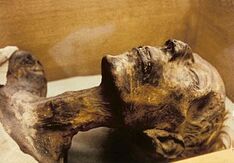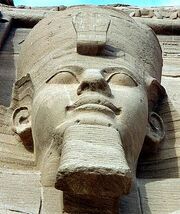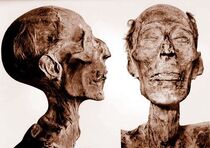Ramses II was born 1303 BC and died in the year 1213 BC, son of Seti I and Queen Tuya, the third pharaoh of the Nineteenth Dynasty of Egypt. He is often regarded as the greatest, most celebrated, and most powerful pharaoh of the Egyptian Empire. He ruled Egypt from 1279 BC to 1213 BC. He took the throne of Egypt in his early twenties (around 1279 BC) and ruled for 66 years until his death (1213 BC). He was the third ruler of the 19th Dynasty and ruled for 67 years, the second longest reign of the ancient Egyptian pharaohs. He focused on building through Egypt (temples, buildings) including his own memorial temple called Ramessuem. He helped to improve Egypt's wealth from collecting supplies from other empires during his reign.
Mummification
The brain was removed using a long hook that was inserted through his nasal cavity. After the brain was completely removed, they filled his nasal cavity with peppercorns, seeds, and small animal bones to retain the unique structure of Ramses II's nose (2011).

Mummy of Ramesses II
The embalmers then individually wrapped his toes, fingers, arms and legs which shows fine attention to detail and precision. Once every part of his body was wrapped, they placed the Book of the Dead between his hands (Fitzgerald, 2009).
Finally, Ramses II's body was draped in a white cloth and the embalmers carefully painted an image of Osiris (the Egyptian God of the underworld) on the outside of the wrappings as a finishing touch (Fitzgerald, 2009).
Ramesses II was originally buried in the tomb KV7 in the Valley of the Kings, Egypt but, because of looting, priests later transferred the body to a holding area, re-wrapped it, and placed it inside the tomb of queen Inhapy. Seventy-two hours later it was again moved, to the tomb of the high priest Pinudjem II. All of this is recorded in hieroglyphics on the linen covering the body. Today his mummy is in Cairo's Egyptian Museum.
Studies
The pharaoh's mummy reveals an aquiline nose and strong jaw, stood at about 1.7 metres (5 ft 7 in), had fair skin and red hair.
Pathology
By the time of his death, aged about 90 years, Ramesses was suffering from severe dental problems and was plagued by arthritis and hardening of the arteries. He was found to have had ankylosing spondylitis, an inflammation of the joints of the spine, which could have made him walk with a hunched back in old age.
Additional
In 1974 Egyptologists visiting his tomb noticed that the mummy's condition was rapidly deteriorating and flew it to Paris for examination.

Ramesses II was issued an Egyptian passport that listed his occupation as "King (deceased)". The mummy was received at Le Bourget airport, just outside Paris, with the full military honours befitting a king. The mummy was then transported to the Paris Ethnological Museum, where it was examined. The researchers discovered that the deterioration of the mummy was caused by a fungal infestation, and it was treated to mitigate the threat
External Links
http://egyptianburials.blogspot.ca/2011/03/ramesses-ii-treatment-of-deceased-and.html
http://www.ancient-egypt-online.com/ramses-II.html https://www.ancient-origins.net/history-famous-people/mummy-passport-0010944
Mark, J. (2009, September 2). Ramessis II. Retrieved October 15, 2015, from www.ancient.eu/Ramesses_II/ Ancient Egyptian Burials: Ramesses II& Nefertari. (2011, March 28). Retrieved October 15, 2015, from
